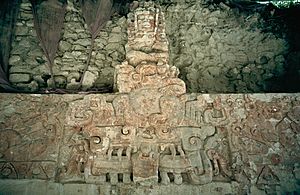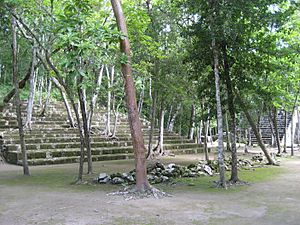Balamku facts for kids
Balamku is a small Maya archaeological site in Campeche, Mexico. It's famous for its amazing plaster art from ancient times. This art, called stucco friezes, dates back to the Early Classic period (around AD 300–600). Balamku has one of the largest and best-preserved stucco friezes in the entire Maya world! People first lived here around 300 BC.
Contents
Where is Balamku?
Balamku is located about 50 kilometers (31 miles) north of the big Maya city of Calakmul. It's also about 60 kilometers (37 miles) west of Xpujil. The ruins are on a flat, rocky area called a karstic plateau, which means it's made of limestone and doesn't drain water very well.
The buildings at Balamku look a lot like those found in the Petén region to the south. However, you can also see some influences from the Río Bec style of architecture.
History of Balamku
Balamku was lived in for a long time, from about 300 BC (Late Preclassic period) until around AD 1000 (Terminal Classic period). The oldest buildings at the site are found in the Central and South Groups. They were built when the Late Preclassic period was ending and the Early Classic period was beginning.
The ruins were discovered in 1990 by a Mexican archaeologist named Florentino García Cruz. He was with INAH (Mexico's National Institute of Anthropology and History) workers. They were checking out a report about people illegally digging for artifacts. They found a trench that had partly uncovered a painted stucco frieze. This frieze was originally part of the outside of an Early Classic building.
After some quick rescue work, the site was officially dug up between 1994 and 1995. A team led by Mexican archaeologist Ramón Carrasco worked on the Central Group. Two French archaeologists, Claude Baudez and Jean Pierre Courau, explored the South Group.
What Does the Site Look Like?
The ruins of Balamku cover an area of about 25 hectares (62 acres). There aren't many buildings far away from the main groups. If you walk about 100 meters (330 feet) from the main areas, you won't find many more structures.
Main Building Areas
The ruins are divided into four main building areas. The Central and North Groups are located near water sources.
Central Group
The Central Group has three main open areas, like town squares, called Plaza A, B, and C.
Plaza A is at the very south of the Central Group. It has a Mesoamerican ballcourt, where ancient Maya people played a special game. There are also some mounds here that haven't been explored by archaeologists yet.
Plaza B is in the northwest part of the Central Group. It's surrounded by buildings: Structure I to the north, Structure IV to the south, and structures V and VI on the east and west sides. Digging here has shown that buildings existed as far back as the Late Preclassic period. This was the earliest time people were active at the site.
Plaza C is separated from Plaza B by Structure V. It has Structure II on its north side and Structure III on its west side. Other unexcavated buildings surround it on the south side.
South Group
The South Group has four plazas, named A through D. These plazas are surrounded by various structures. For example, Plaza A is enclosed by Structure D5-5, D5-10, and D5-11.
Southwest Group
The Southwest Group has two buildings that form an E-Group complex. This type of complex was used by the Maya to observe the sun and track important dates like the equinoxes and solstices.
North Group
The North Group hasn't been dug up by archaeologists yet, but they have made maps of it. It has six plazas surrounded by buildings. Some of these buildings are quite tall, over 15 meters (49 feet) high!
Important Buildings
Structure I is in the Central Group. When archaeologists dug into an older building underneath it (called Sub I-A), they found an amazing stucco frieze. This frieze is a long, detailed sculpture made of plaster. It's believed to be from between the 4th and 6th centuries AD. The frieze was first found by people illegally digging, but then it was fully uncovered by INAH.
The complete frieze is about 16.8 meters (55 feet) long and 1.75 meters (5.7 feet) high. It shows pictures of rulers along with a sacred mountain. The frieze was found almost perfectly preserved! Today, it's protected by a roof and visitors can go see it.
Structure D5-5 is in the South Group. Archaeologists found two burials inside this building, and one of them was a person of high status, like a ruler or important leader.
Structure D5-11 is also in the South Group. It's one of the oldest known buildings at Balamku, dating back to the Late Preclassic period.
See also
 In Spanish: Balamkú para niños
In Spanish: Balamkú para niños



